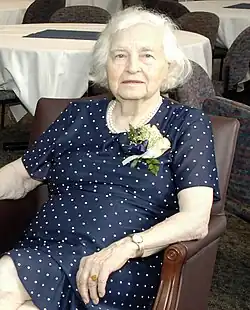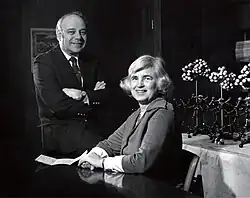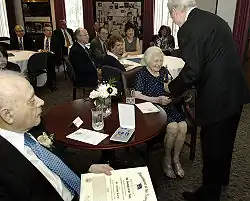Isabella Karle
Isabella Karle | |
|---|---|
 Karle at her retirement in 2009 | |
| Born | Isabella Helen Lugoski December 2, 1921 |
| Died | October 3, 2017 (aged 95) Alexandria, Virginia, U.S. |
| Resting place | Columbia Gardens Cemetery Arlington, Virginia, U.S. |
| Alma mater | University of Michigan, BS, MS, PhD |
| Spouse | |
| Children | 3 |
| Awards | Society of Women Engineers Achievement Award (1968) Garvan–Olin Medal (1976) Gregori Aminoff Prize (1988) Bower Award (1993) National Medal of Science (1995) |
| Scientific career | |
| Fields | Crystallography |
| Doctoral advisor | Lawrence O. Brockway |
Isabella Helen Karle (née Lugoski; December 2, 1921 – October 3, 2017) was an American chemist who revolutionized crystallography laying the foundation for three-dimensional structures of molecules which facilitates the study of the biological, chemical, metallurgical, and physical characteristics of the molecules. This information provides the ability to synthesize those molecules. Her method improved the speed and accuracy of chemical and biomedical analysis and enabled the development of new pharmaceutical products and other synthesized materials.[1] For her scientific work, Karle received the Society of Women Engineers' Achievement Award, the Garvan–Olin Medal, Gregori Aminoff Prize, Bower Award, National Medal of Science, and the Navy Distinguished Civilian Service Award (which is the Navy's highest form of recognition to civilian employees).
Early life


Isabella Helen Lugoski was born in Detroit, Michigan, on December 2, 1921, the daughter of immigrants from Poland.[2] Her father, Zygmunt Lugoski, worked for the city's transportation system. Her mother, the former Elizabeth Graczyk, was a self-educated woman who supported her family as a seamstress of automobile upholstery and later by running a restaurant–eventually with Isabella's help,[3] who became the restaurant's accountant after discovering a love for numbers.[4] She attended the local public schools and skipped two grades in elementary school,[4] despite not speaking English until the first grade.[3] While at school, a female chemistry teacher led her to her pursuit of the field as a career.[5] She also drew inspiration from a biography of Marie Curie.[2] She attended Wayne University (now Wayne State University) in Detroit for a semester before obtaining a four-year scholarship to the University of Michigan, where she majored in physical chemistry and received a Bachelor of Science at age 19, followed by Master of Science and Ph.D. degrees in the field. During her graduate work she met her future husband and scientific collaborator, Jerome Karle, in a physical-chemistry lab where alphabetical seating dictated that the two of them would sit next to each other; the two were both advised in their Ph.D. studies by Lawrence Brockway.[6][7]: 89 The pair married in June 1942 after Isabella completed her M.S. degree.[8]
Career
Karle worked on the Manhattan Project during World War II, where she developed techniques to extract plutonium chloride from a mixture containing plutonium oxide.[9] After the war, she worked at the University of Michigan where she was the first female member of the chemistry faculty.[1]
She then joined the United States Naval Research Laboratory (NRL). At the NRL, her husband Jerome developed "direct methods" for analyzing structure of crystals. Their experimental apparatus for electron diffraction for characterizing the structures of gaseous molecules provided invaluable insights into key principles that led them later to their successful treatment of the phase problem in X-ray crystallography. However, for many years the crystallographic community remained skeptical about their utility.[2][10] Isabella Karle was the first person to apply the method. She developed the symbolic addition procedure that connects the theoretical "direct method" apparatus and actual X-ray diffraction data.[10] These contributions advanced the field of X-ray crystallography by enabling determination of the structure of crystals.
One of the first successes of solving crystal structures was determining the structure of the venom of a South American frog. Understanding the mechanism used by the venom to block specific nerve transmission proved to be very useful for the study of nerve transmission for medical purposes. Based on her work, a synthetic from of the venom could be manufactured. This technique has played a major role in the development of new pharmaceutical products and other synthesized materials.[9][11]
In 1985, Jerome Karle was awarded the Nobel Prize in Chemistry, together with mathematician Herbert A. Hauptman, for developing direct methods for analyzing X-ray diffraction data. The Nobel Committee ignored Isabella's crucial role in solving the problem in practice, and Jerome Karle and many other members of the crystallography community strongly believed that Isabella Karle should have shared the prize.[10][2]
Karle was the first to publish the structures of many important molecules. As her successes became known, Isabella brought young women into her laboratory and taught them crystallography. And, as her fame for solving the structures of many difficult crystals spread throughout the community, collaborators across the world sent her samples of their crystals in glass vials. Her models of frog toxins are exhibited at the American Museum of Natural History in NYC.[3]
On July 31, 2009, Karle and her husband retired from the Naval Research Laboratory.[9] Retirement ceremonies for the Karles were attended by United States Secretary of the Navy Ray Mabus, who presented the couple with the Department of the Navy Distinguished Civilian Service Award, the Navy's highest form of recognition to civilian employees.[9] Over her career, Karle published nearly 300 scientific papers.[11]
Affiliations
Karle served as President of the American Crystallographic Association. She was a member of the American Physical Society and the American Chemical Society.
Awards
Karle received many honors and awards. Her first award was the Society of Women Engineers’ 1968 Achievement Award. She was elected to the National Academy of Sciences in 1978. She received eight honorary doctorates and awards from the U.S. Navy. (1993).[12][13] She was a Fellow of the American Academy of Arts and Sciences and was elected to the American Philosophical Society in 1992.[14] In addition, she received the National Medal of Science from President Clinton (1995) and eight honorary doctorates.[15]
- Society of Women Engineers' Achievement Award (1968)
- Garvan–Olin Medal (1976)
- Rear Admiral William S. Parsons Award (1988)
- Gregori Aminoff Prize, Royal Swedish Academy of Science (1988)
- Bijvoet Medal of the Bijvoet Center for Biomolecular Research (1989) [15]
- Bower Award and Prize for the Advancement of Science, Franklin Institute, first woman, “for determining three-dimensional structures of molecules with X-ray diffraction” (1993)
- National Medal of Science, received from President Clinton, “For the development and application of a method for determining essentially equal-atom crystal and molecular structures by x-ray analysis, thereby having a profound effect on the practice of organic and biological chemistry (1995)
- Navy Distinguished Civilian Service Award (2009)
Legacy
Her x-ray scattering technique is used to study biological, chemical, metallurgical, and physical characteristics of crystals. It significantly improved the speed and accuracy of chemical and biomedical analysis and is still today the basis of all advanced x-ray crystallography including computerized programs used around the world. Her technique has played a major role in the development of new drugs and other synthesized materials.[1]
Personal life
Karle was married to Jerome Karle, with whom she had three daughters, all of whom work in scientific fields:[16]
- Louise Karle (born 1946) is a theoretical chemist
- Jean Karle (1950) is an organic chemist
- Madeleine Karle (1955) is a museum specialist with expertise in the field of geology.
Death
_and_Isabella_Lugoski_Karle_(1921-2017).jpg)
She died on October 3, 2017, at a hospice in Alexandria, Virginia[2] at 95 from a brain tumor. She was exposed to radiation during her work on the Manhattan project.
References
- ^ a b c "Isabella L. Karle". National Science & Technology Medals Foundation. Retrieved 23 January 2025.
- ^ a b c d e "Isabella L. Karle, chemist who helped reveal structure of molecules, dies at 95". Washington Post.
- ^ a b c Schlick, Tamar (July 2021). "Isabella L. Karle: A Crystallography Pioneer". DNA and Cell Biology. 40 (7): 843–847. doi:10.1089/dna.2021.0372. ISSN 1557-7430. PMC 8309433. PMID 34129390.
- ^ a b Chang, Kenneth (2017-10-26). "Isabella L. Karle Dies at 95; Findings on Molecules Helped Husband Win Nobel". The New York Times. ISSN 0362-4331. Retrieved 2025-04-04.
- ^ Staff. " profile", Journal of Chemical Education. Accessed September 22, 2009.
- ^ "Jerome Karle - Biographical". Nobelprize.org. Retrieved 10 March 2017.
- ^ Kelly, Cynthia C. (27 January 2005). Remembering the Manhattan Project: Perspectives on the Making of the Atomic Bomb and Its Legacy. World Scientific. ISBN 9789814481786.
- ^ "Isabella Karle - Nuclear Museum". ahf.nuclearmuseum.org. Retrieved 2025-04-04.
- ^ a b c d McKinney, Donna. "Jerome and Isabella Karle Retire from NRL Following Six Decades of Scientific Exploration" Archived 2011-09-27 at the Wayback Machine, United States Naval Research Laboratory press release dated July 21, 2009. Accessed September 22, 2009.
- ^ a b c "Isabella Karle dies at age 95 | Chemical & Engineering News". cen.acs.org. Retrieved 2018-12-19.
- ^ a b Shearer, Benjamin F.; Shearer, Barbara S. (1997). Notable Women in the Physical Sciences: A Biographical Dictionary. Westport, Connecticut: Greenwood Press. ISBN 9780313293030.
- ^ "Isabella L. Karle". www.nasonline.org. Retrieved 2022-04-01.
- ^ "Book of Members, 1780–2010: Chapter K" (PDF). American Academy of Arts and Sciences. Retrieved July 29, 2014.
- ^ "APS Member History". search.amphilsoc.org. Retrieved 2022-04-01.
- ^ "Isabella Karle, Renowned Crystallographer and Chemist, Dies at 95". News. 2017-10-24. Retrieved 2018-12-19.
- ^ Jerome Karle: The Nobel Prize in Chemistry 1985, Nobel Prize. Accessed September 22, 2009.
Further reading
- Wayne, Tiffany K (2011). American women of science since 1900. ABC-CLIO. ISBN 9781598841596. OCLC 702118874.
- Shearer, Benjamin F; Shearer, Barbara Smith (1997). Notable women in the physical sciences a biographical dictionary. Greenwood Press. ISBN 978-0-313-29303-0.
- Tietjen, Jill S. (2025). "Chapter 22 Isabella Karle". In Craig, Cecilia D.; Johnson, Vicki S.; Kimberling, Debra; Teig, Holly J.; Tietjen, Jill S.; Williams, Jan (eds.). Women Engineering Legends 1952-1976: Society of Women Engineers Achievement Award Recipients. Springer. ISBN 978-3-032-00223-5.
External links
- 2015 Video interview with Isabella Karle by the Atomic Heritage Foundation Voices of the Manhattan Project
- 2005 Video Interview with Isabella Karle by the Atomic Heritage Foundation Voices of the Manhattan Project
- Massa, Antonia (2013). "Isabella Karle's Curious Crystal Method". Narratively: Human stories, boldly told. Retrieved 2013-12-05.